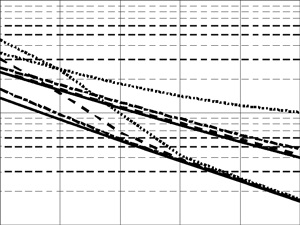Two-stage method for joint estimation of information symbols and channel frequency response in OFDM communication systems
DOI:
https://doi.org/10.3103/S073527272008004XKeywords:
OFDM, quasi-optimal algorithm, orthogonal frequency division multiplexing, frequency response, communication channel, information symbolAbstract
The optimal and quasi-optimal algorithms of two-stage joint estimation of information symbols and frequency response (FR) of multibeam channels in OFDM-based communication systems have been synthesized. They involve the calculation of a posteriori probability density of estimated processes. At the first stage, the recurrent calculation of joint a posteriori distributions of information symbols and the frequency response is performed from two sides of the measurement vector. At the second stage, a posteriori distributions are combined on each of subcarriers that are obtained as a result of the first stage estimation. Based on the obtained a posteriori distributions, estimates of the information symbol and channel FR are determined by the criteria of a posteriori probability maximum and the average mean squared error minimum, respectively. The performance of synthesized algorithms similar to the well-known MMSE algorithm involves the need of knowledge of statistical properties of communication channel. The device implementing the optimal algorithm is multichannel, each channel of which is matched with the corresponding value of symbol from the modulation constellation. The quasi-optimal algorithm was obtained by using the Gaussian approximation of a posteriori probability density. It should be noted that this algorithm preserves its multichannel structure. The approbation of the presented algorithm was conducted using the computer-aided statistical simulation for different parameters of multibeam communication channels and the comparison of the obtained results with the results obtained by the MMSE and LS algorithms. The simulation results showed that the error probability decreases by about 2 times with a maximum signal propagation delay of 100 μs.References
- M. Speth, S. A. Fechtel, G. Fock, H. Meyr, “Optimum receiver design for wireless broad-band systems using ofdm. i,” IEEE Trans. Commun., vol. 47, no. 11, pp. 1668–1677, 1999, doi: https://doi.org/10.1109/26.803501.
- M. Speth, S. Fechtel, G. Fock, H. Meyr, “Optimum receiver design for ofdm-based broadband transmission. ii. a case study,” IEEE Trans. Commun., vol. 49, no. 4, pp. 571–578, 2001, doi: https://doi.org/10.1109/26.917759.
- P. S. R. Diniz, Adaptive Filtering. Cham: Springer International Publishing, 2020, doi: https://doi.org/10.1007/978-3-030-29057-3.
- A. Moussa, M. Pouliquen, M. Frikel, S. Bedoui, K. Abderrahim, M. M’saad, “An overview of blind equalization algorithms for digital communications,” in 2019 19th International Conference on Sciences and Techniques of Automatic Control and Computer Engineering (STA), 2019, pp. 491–496, doi: https://doi.org/10.1109/STA.2019.8717267.
- A. A. Shpylka, S. Y. Zhuk, “Joint interpolation of data and parameter filtration of a multibeam communications channel,” Radioelectron. Commun. Syst., vol. 53, no. 1, pp. 20–24, 2010, doi: https://doi.org/10.3103/S0735272710010048.
- Z. Jiang, X. Shen, H. Wang, Z. Ding, “Joint psk data detection and channel estimation under frequency selective sparse multipath channels,” IEEE Trans. Commun., vol. 68, no. 5, pp. 2726–2739, 2020, doi: https://doi.org/10.1109/TCOMM.2020.2975172.
- T.-D. Chiueh, P.-Y. Tsai, I.-W. Lai, Baseband Receiver Design for Wireless MIMO-OFDM Communications, 2nd ed. Singapore: John Wiley & Sons Singapore Pte. Ltd., 2012, doi: https://doi.org/10.1002/9781118188194.
- N. Suga, R. Sasaki, T. Furukawa, “Channel estimation using matrix factorization based interpolation for ofdm systems,” in 2019 IEEE 90th Vehicular Technology Conference (VTC2019-Fall), 2019, vol. 2019-Septe, pp. 1–5, doi: https://doi.org/10.1109/VTCFall.2019.8891572.
- J.-J. van de Beek, O. Edfors, M. Sandell, S. K. Wilson, P. O. Borjesson, “On channel estimation in ofdm systems,” in 1995 IEEE 45th Vehicular Technology Conference. Countdown to the Wireless Twenty-First Century, 1995, vol. 2, pp. 815–819, doi: https://doi.org/10.1109/VETEC.1995.504981.
- O. Edfors, M. Sandell, J.-J. van de Beek, S. K. Wilson, P. O. Borjesson, “OFDM channel estimation by singular value decomposition,” IEEE Trans. Commun., vol. 46, no. 7, pp. 931–939, 1998, doi: https://doi.org/10.1109/26.701321.
- X. Dai, W. Zhang, J. Xu, J. E. Mitchell, Y. Yang, “Kalman interpolation filter for channel estimation of lte downlink in high-mobility environments,” EURASIP J. Wirel. Commun. Netw., vol. 2012, no. 1, p. 232, 2012, doi: https://doi.org/10.1186/1687-1499-2012-232.
- S. V. Vishnevyy, S. Y. Zhuk, “Two-stage mutual causal filtration and segmentation of heterogeneous images,” Radioelectron. Commun. Syst., vol. 54, no. 1, pp. 37–44, 2011, doi: https://doi.org/10.3103/S0735272711010067.
- A. Y. Myronchuk, O. O. Shpylka, S. Y. Zhuk, “Channel frequency response estimation method based on pilot’s filtration and extrapolation,” Visnyk NTUU KPI Seriia - Radiotekhnika Radioaparatobuduvannia, no. 78, pp. 36–42, 2019, doi: https://doi.org/10.20535/RADAP.2019.78.36-42.
- M. N. Sluzhivyi, “Recurrent adaptive algorithms of signals reception in fading channels,” Vestn. UlGTU, no. 4, pp. 24–26, 2009, uri: https://www.elibrary.ru/item.asp?id=20171746.
- M. N. Sluzhivyi, Y. V. Kukanova, “Autoregressive models of fading in multibeam communication channel,” Vestn. UlGTU, no. 3, pp. 44–46, 2008, uri: https://www.elibrary.ru/item.asp?id=20186491.
- W. Chen, R. Zhang, “Kalman-filter channel estimator for ofdm systems in time and frequency-selective fading environment,” in 2004 IEEE International Conference on Acoustics, Speech, and Signal Processing, 2004, vol. 4, pp. iv-377-iv–380, doi: https://doi.org/10.1109/ICASSP.2004.1326842.
- V. I. Tikhonov, V. N. Kharisov, Statistical Analysis and Synthesis of Radio Devices and Systems. Moscow: Radio i Svyaz’, 2004.
- T. V. Baringolts, D. V. Domin, S. Y. Zhuk, V. V. Tsisarzh, “Adaptive algorithm of maneuvering target tracking in complex jamming situation for multifunctional radar with phased antenna array,” Radioelectron. Commun. Syst., vol. 62, no. 7, pp. 342–355, 2019, doi: https://doi.org/10.3103/S0735272719070021.
- A. P. Trifonov, Y. S. Shinakov, Joint Discrimination of Signals and Estimation of Their Parameters against the Background of Interferences. Moscow: Radio i Svyaz’, 1986.
- C. K. Chui, G. Chen, Kalman Filtering, 5th ed. Cham: Springer International Publishing, 2017, doi: https://doi.org/10.1007/978-3-319-47612-4.
- L. M. Correia, Mobile Broadband Multimedia Networks, 1st ed. Cambridge, MA: Academic Press, 2006, uri: https://www.elsevier.com/books/mobile-broadband-multimedia-networks/correia/978-0-12-369422-5.

Downloads
Published
2020-08-24
Issue
Section
Research Articles

